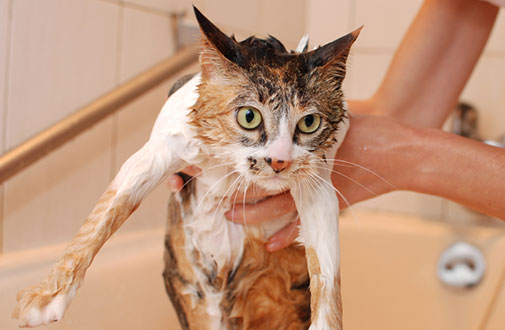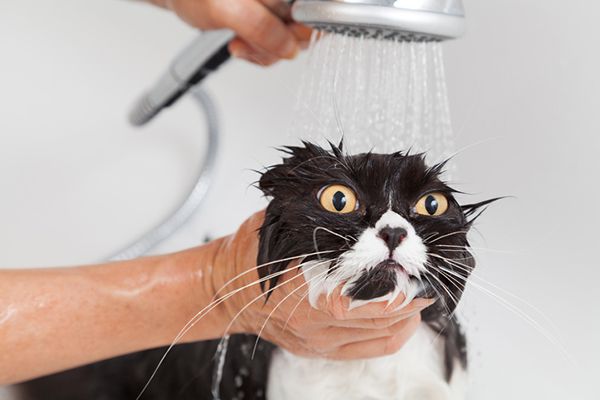As any cat owner knows, cats are fastidious groomers. They spend hours each day licking their fur, and one may be tempted to think they do not need a bath.
But your cat needs regular baths for a couple of reasons. For one thing, it can help to remove any dirt or debris that your cat may have picked up while exploring outdoors.
In addition, it can help to reduce the amount of shedding by keeping the fur clean and free of tangles.
And if your cat happens to get into something sticky or smelly, a bath can be a quick and easy way to get them clean again.
Should You Bathe A Cat With Ringworm?

Pet parents often get confused about whether or not they should bathe a cat that has ringworms.
In case you are unsure, the answer is yes, you should.
Bathing your cat is actually one of the surefire ways of controlling the infection – as long as you do it the right way.
Here are some of the top reasons why you should bathe a cat with ringworms:
I. It Helps To Remove the Spores from Their Fur
When your cat has ringworm, he will have spores in his fur which can infect other animals and people.
By bathing your cat, you can help to remove these spores and prevent the infection from spreading.
II. It Can Help To Reduce the Amount of Shedding
If your cat is infected with ringworm, he may shed more than usual. This is because the spores can cause irritation and inflammation of the skin.
Bathing your cat can help to remove the spores and reduce the amount of shedding.
III. It Can Help To Control the Itch
Ringworm can be very itchy, and your cat may scratch themselves raw trying to relieve the itch. This can lead to further irritation and even infection.
Bathing your cat can help to remove the spores and soothe the itch.
IV. It Can Help To Prevent Secondary Infections
If your cat scratches themselves raw, they are at risk of developing a secondary infection. This is because the spores can enter through the open wounds and cause an infection.
Bathing your cat can help to remove the spores and prevent secondary infections.
V. It Can Help To Keep the Area Clean
When your cat has ringworm, the affected area can become crusted and scabby. This can be a breeding ground for bacteria and other microbes.
Bathing your cat can help to remove the crust and keep the area clean.
Will Bathing A Cat With Ringworm Make The Condition Worse?
There is a common misconception that bathing a cat with ringworm will worsen the condition.
But the truth is bathing can actually help to improve the condition.
As we have established, there are lots of benefits of bathing a cat that has ringworms including removing the spores that caused the fungal infection, preventing secondary infections, and reducing the shedding of fur which could result in the spreading of the infection to other cats.
Just be sure to use a mild shampoo and avoid getting any water in their eyes, nose, or mouth.
How Often Should You Bathe A Cat With Ringworm?
According to VCA animal hospitals, bathes meant to control ringworms in cats should be done weekly.
Bathing a cat too often can strip away the natural oils that keep their fur healthy and looking its best, so a weekly bath should suffice.
Spores can live in the environment for up to two weeks, so the weekly bathe should do a good job in managing the infection – as long as an appropriate antifungal shampoo is used.
However, your vet may recommend more frequent baths depending on the severity of the condition. If you are unsure, consult with the vet.
How to Actually Bathe a Cat with Ringworm

To bathe a cat with ringworms, you will need:
- Antifungal shampoo
- Warm water
- Rubber Gloves
- Brush
- Towel for drying
- Cotton Balls
- Blow dryer (if you have a long-haired cat)
- Bathroom/Kitchen sink (These will give you more control than a human bathtub as the cat will have less space to move around. It will also be easier on you and your helper’s back).
Step 1
Choose a good time of the day—preferably a calm moment when your kitty is easy and relaxed. Avoid bathing her at her peak activity moments or when she is hungry.
To make the whole process smooth and painless, you also need to choose a time when you are free and have enough time on your side—never be in a rush.
Step 2
Brush the cat before bathing her to detangle potential knots or matted fur. This is step is important if you have a long-haired breed.
Knots and matted fur may trap shampoo, causing irritations and infections later on.
Step 3
Fill the sink with a few inches of warm water before putting the cat in.
You don’t need to fill the sink with water if your sink comes with a spray nozzle that can be set to operate at a low setting.
Consider putting a non-slip mat in the sink to provide the cat with traction.
A surface that’s too slippery for your kitty may lead to distress and chaos.
Step 4
It is now time to get your cat wet.
Start by placing her in the sink. Hold her by the scruff or a cat harness.
Either allow her to stand on her four legs on the mat (see the video below) or on her back two feet—whatever she is comfortable with.
Start by slowly wetting his fur with the sink nozzle or a small cup (if your sink doesn’t come with a nozzle). This step is important as it will help the shampoo to be more effective.
Start from the base of her tail and work your way up (slowly) to her neck.
Step 5
Once done, apply a small amount of shampoo to their fur and work it in well. Again, work towards her neck from the base of her tail.
As you do this, avoid getting any water in their eyes, nose, or mouth and pay lots of attention to the problem areas.
The best way to avoid water from getting into her eyes and ears is to put cotton balls in these areas.
Allow a couple of minutes for the shampoo to settle.
Step 6
The next step is to give your feline friend a good rinse with warm water.
Keep rinsing the cat until all the shampoo has been washed away from the coat.
As hinted above, lingering traces of shampoo can cause itching, so ensure that her body is totally suds-free.
Step 7
Once you have rinsed the cat thoroughly, dry them off with a towel.
If you have a long-haired breed, consider using a blow dryer to calmly blow the fur dry.
The noise of a blow dryer may make her panic a bit and she may try to sneak away from you. Just hold her tight so that you can dry her fur as possible.
Finally, take the brush and rush through their fur to remove any knots or tangles.
Step 8
After the bath, it is important to clean all of the supplies that you used. This includes the towel, brush, and shampoo.
Be sure to wash them in hot water or disinfect them with bleach. This will help to prevent the spores from spreading.
In addition, all of the cat’s bedding and toys will need to be washed in hot water.
Be sure not to use the brush and towel on other cats and pets as these items might easily spread the fungi to the other pets.
Here is a great video about the process (courtesy of Dubaikennelscattery)
Summary
To sum it up, it is safe and recommended by vets to bathe cats that have ringworms.
You will want to use the antifungal shampoo once a week for at least six weeks.
However, washing with antifungal shampoo shouldn’t be used as a replacement for medication but as a complement.
You will still need to use the oral or topical drugs as prescribed by the vet.
Here are other strategies you can leverage to get rid of ringworm from your cat: How to Treat Ringworm in Cats without Going to the Vet (15 Strategies)
And below are more posts about cats and ringworms. Check them out for more insights on how to handle ringworms in your kitty:
Petting a Cat with Ringworm: A Quick Guide for new Kitty owners
How Much Does It Cost To Treat Ringworm In Cats?
My Kitten Has Ringworm: Should I Get Rid Of Her?

Hi! I am Eleanor Price. I started this website after my cat, Louie, almost died from a case of botulism (a type of food poisoning often caused by bacteria that grow on food items). Turned out that my cat’s diet was the problem. I have made it my duty to provide the best information and recommendations about everything cat lovers need to know about their felines’ health and wellbeing. My goal is to find the most informative content on anything feline-related and share it with fellow hardworking kitty lovers.

